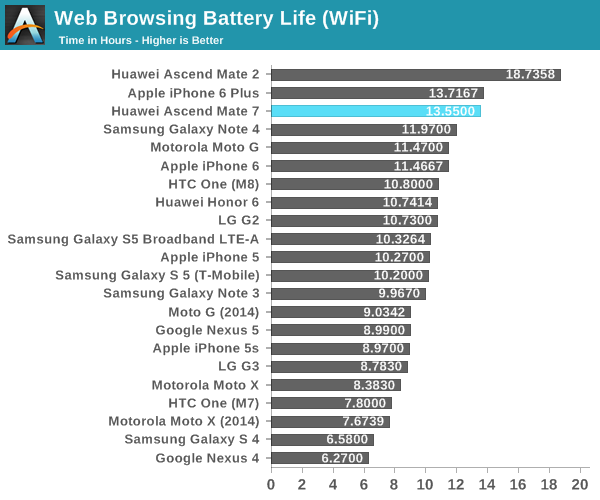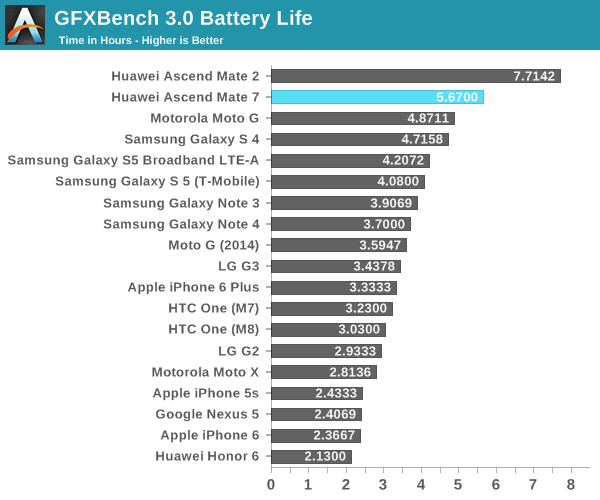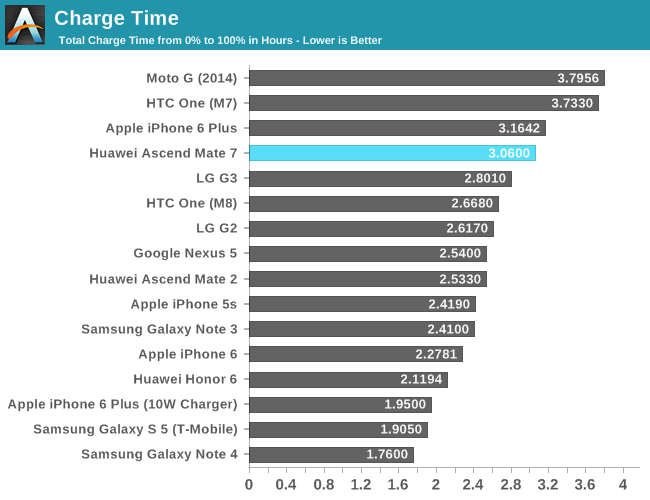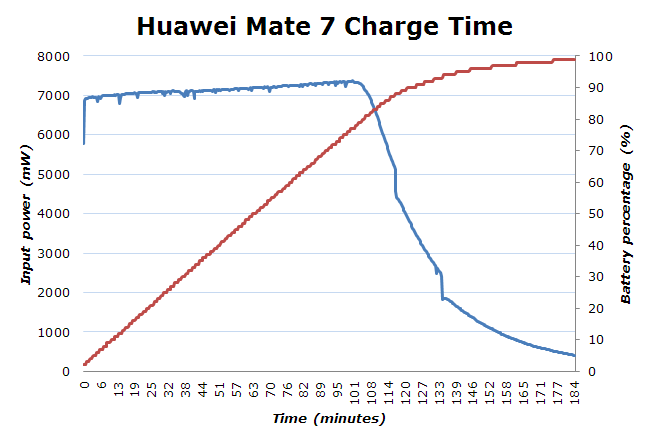The Huawei Ascend Mate 7 Review
by Andrei Frumusanu on December 2, 2014 8:00 AM EST- Posted in
- Smartphones
- Huawei
- Mobile
- Ascend Mate 7
- HiSilicon
Battery Life
We find a monstrous 4100mAH battery inside of the Mate 7 which should theoretically provide it excellent runtimes. Let's see if that is the case.

The Wifi web-browsing test ends up at 13.5 hours for the Mate 7. While this is a enormous lifetime for usual Android devices, it's pretty disappointing in conjunction with the size of the battery. The iPhone 6 performs almost equally with a 1200mAh smaller battery. Even the Note 4 with its AMOLED screen which is usual unfavourable to our web-browsing test isn't too far behind with its 3200mAH battery. Of course the Mate 7 has a slightly bigger screen, but it's still only 1080p compared to the Note 4's. I would have expected the Mate 7 to be in the range of its predecessor, the Mate 2, but that device remains very lonely among the top of our battery charts.
I did not do a objective run on 4G to be able to test the new Balong modem inside the Kirin. This is mostly due to a very different test environment than what we've ran our previous devices, mostly by Josh and Brian under 700MHz on AT&T. Here in Luxembourg we still only have access to 1600MHz LTE while 800MHz EUDD is still being freed for commercial use. As such, I prefer to avoid publishing any misleading numbers until I get a good portfolio of devices which I can all run under the same test conditions.
I can however give my subjective opinion on the matter: I haven't been impressed at all by Huawei's new modem. In daily usage under a mobile connection the device gets quite hot and drains the battery more than other devices sporting Qualcomm modems. I'm very skeptical of Huawei's modem and RF back-end, and hope that in the future they'll be able to improve power consumption.

You might be wondering where the Mate 7 is on the BaseMark OS II graph. The truth is rather ugly.
I've tried several times to complete the battery test on BaseMark OS II and failed each time. After 25 minutes the device would shut off due to overheating and reach scorching hot temperatures. This is the hottest I have ever seen any mobile device be, and I could not comfortably hold the device after it crashed on the test. The phone discharged at a rate of 0.7% per minute during those 20 minutes, meaning it should have reached about 2.3 hours of lifetime, again one of the worst scores we've ever seen, short of the Honor 6. This projects a sustained TDP of about 6.5W, much above what a phone factor is able to dissipate.

The GFXBench 3.0 battery run is much improved over the Honor 6, again due to more aggressive thermal throttling on the GPU. Here the Mate 7 manages to reach 5.6 hours lifetime, but with a great performance sacrifice.
Overall, I deem the Mate 7 battery life to be bad, and a step back in terms of efficiency. For users who just browse a lot with their device or frequently use social media applications, the Mate 7 performs quite well. If you are a frequent gamer, I'd strictly recommend against the Mate 7.
Charge Time
The Mate 7 uses a what has now become a standard 5V 2A charger. The charger IC sets up a 1750mA input power rate which ends up at around 7W charge power in the fast-charge phase of the battery before it slows down to three slower phases of trickle-charging.

We see a similar charge curve as on the Honor 6; the power decreases a lot after reaching 85% at the 100 minute mark and it takes another 85 minutes to fill the last 15% for a total of a little over 3 hours. This is neither bad considering the 4100mAh battery, but nothing to write home about either, especially since we've seen in the introduction of chargers at increased voltage operation.











72 Comments
View All Comments
tipoo - Tuesday, December 2, 2014 - link
Ach, and that storage performance...Yup, all interest gone.massig93 - Tuesday, December 2, 2014 - link
Thanks for the great review! I'm so thankful you review products that are noto exclusively Samsungs, Apples or HTCs. I'd love to see more chinese phones reviews on anandtech (Xiaomi Mi4, Meizu MX4, Nubia Z7, Nubia X6, Huawei Honor X1)protomech - Tuesday, December 2, 2014 - link
Any comments on wifi performance? No 802.11ac so not expecting much.The Ascend Mate 2 was an interesting device: inexpensive and fantastic battery life, due to the 2011-class resolution and SOC performance. If you wanted a physically large display and were okay with the lower performance then it was easy to recommend.
There's no reason to recommend this phone.
Andrei Frumusanu - Tuesday, December 2, 2014 - link
I'm still lacking the proper equipment for Wifi tests, but from what I can see the Wifi reception and performance didn't change from the Honor 6.alfredska - Tuesday, December 2, 2014 - link
Especially for Android devices, it would be great if you could spend more time discussing a manufacturer's historical commitment to long-term support on their products. This includes: how regularly a product receives OTA updates; how recent the base operating system is (version of Android); whether kernel source is released in a timely manner following each update.In the case of Huawei, I'm very leary, because their first US phone offering, the Mate 2 which was just released this year, still runs Jellybean. While they claim a Lollipop is in its future, this only came after a barrage of harassment from users complaining about abandoned support. Even then, I don't want to give them praise until the update actually exists.
Reference 1: http://blog.gethuawei.com/huawei-device-usa-update...
Despoiler - Tuesday, December 2, 2014 - link
Huawei has been caught numerous times straight up stealing other company's intellectual property. They deployed an exact copy errata and all of Cisco's IOS in their routers. They are in a lawsuit with T-Mobile for corporate espionage. They also got caught siphoning non-anonymous user data from their cell phones and then they lied about doing it. Huawei is a government sponsored corporation and the Chinese government uses it to do whatever they want. I wouldn't anywhere near any Huawei product.pgari - Tuesday, December 2, 2014 - link
The performance charts should have included the Nexus 6 and OnePlus One results, which have already been reviewed by Anandtechpichemanu - Tuesday, December 2, 2014 - link
Hi, just today I read another review and they didn't encounter any overheating nor did they have problems in low light photography. Also the autonomy was quite good (5h of gaming if I recall correctly)Is the terminal you reviewed on the latest firmware? Maybe a defective unit or another hw revision could explain this.
Andrei Frumusanu - Tuesday, December 2, 2014 - link
It was on the a late October released firmware.I'm getting the same gaming battery life of 5h (5.6h!) as pointed out in the review, I don't think there's changes in that regard.
pichemanu - Wednesday, December 3, 2014 - link
Sorry for the gaming autonomy number, I mistakenly remembered around 2h.